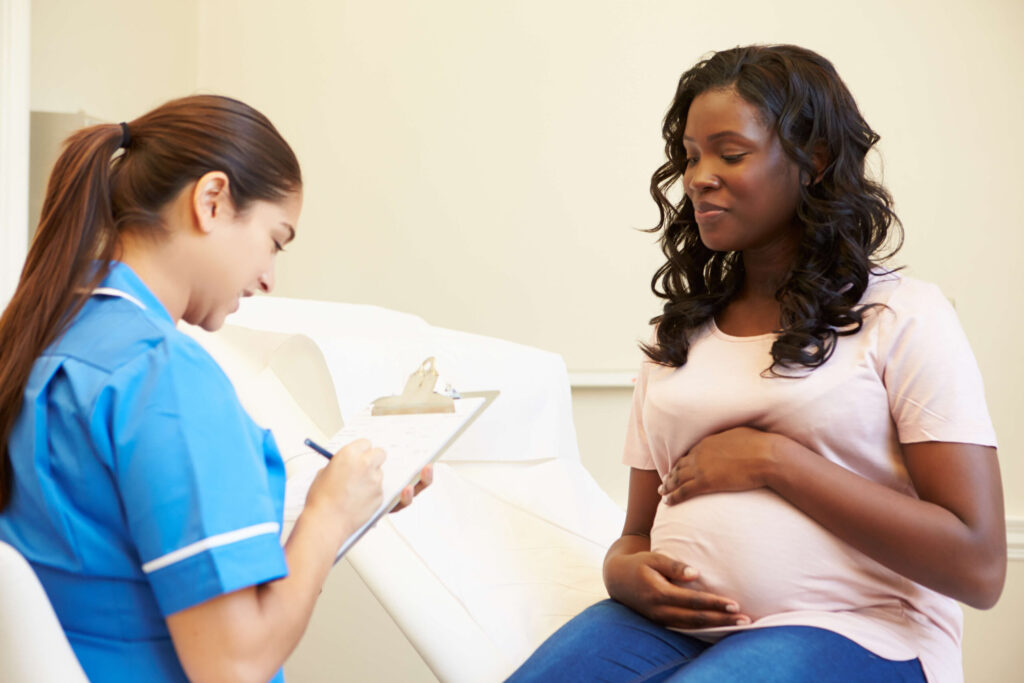The U.S. is facing a maternal health crisis, with the rate of maternal mortality steadily increasing over the last several years despite the U.S. having one of the most advanced health systems in the world. The COVID-19 pandemic also shed light on racial inequities that have existed in maternal mortality and morbidity. The maternal death rate for Black women rose from 44 per 100,000 live births in 2019 to 68.9 in 2021 as compared to the maternal death rate for White women, which was 17.9 in 2019 and 26.1 in 2021. According to a study by the Government Accountability Office, the COVID-19 pandemic exacerbated maternal disparities in social determinants of health including access to health care, transportation and employment.
Maternal mortality is a federal and state priority. In June 2022, the Biden-Harris Administration declared maternal mortality a public health crisis, releasing the White House Blueprint for Addressing the Maternal Health Crisis to encourage federal and state policymakers to develop and improve policies that will make maternal care more equitable and safe, and improve the overall birthing experience for all people.
Each year, governors give a State of the State address, highlighting their priorities for the upcoming year. NASHP conducted an analysis of these state addresses — with 36 available at the time of this analysis — highlighting initiatives that address maternal and child health. Ten governors identified addressing maternal health as a key priority of their administration. Three main themes were identified including:
- Extending Medicaid postpartum coverage past 60 days
- Creating a task force or state-wide initiative addressing maternal mortality
- Expanding or initiating new services for expectant and new mothers
Extending Medicaid Coverage to 12 Months Postpartum
Governors in four states (Alaska, Georgia, Tennessee, and Utah) specifically referenced some form of Medicaid postpartum coverage extension as a top priority in the coming year. Under the American Rescue Plan Act of 2021 (ARPA), states were provided the option to extend postpartum coverage from 60 days to 12 months under a Medicaid state plan amendment. (Previously states could only see this extension of coverage through a Section 1115 demonstration.) The ARPA provision was effective until 2027, but the option was made permanent under the Appropriations Act of 2023. Thirty-one states and Washington, DC have already taken action to expand postpartum coverage to 12 months.
Governor Mike Dunleavy of Alaska, Governor Bill Lee of Tennessee and Governor Spencer Cox of Utah called out a desire to support families and have included expanding postpartum Medicaid coverage within larger efforts to build a more “pro-family” landscape. Governor Brian Kemp of Georgia also expressed the need to prioritize the health and well-being of new and expectant mothers with calls to expand both postpartum Medicaid coverage along with other services.
Since the State of the State addresses, the following legislation has occurred. In Tennessee, postpartum coverage has been extended to 12 months under a state plan amendment. In Georgia, the state plan amendment was approved in November 2022. In Utah, a bill has been passed and signed by the governor in March to submit an amendment or waiver for the 12-month extension and in Alaska a bill to extend coverage is currently under review in the House Finance Committee.
State Efforts to Extend Medicaid Postpartum Coverage
Expanding Services for Expectant and New Mothers
There is a growing interest in increasing available services to pregnant and postpartum people during the perinatal period for both the mother and infant. Nine governors (Alaska, Georgia, Iowa, Michigan, Nebraska, Ohio, South Dakota, Tennessee, and Utah) expressed interest in expanding services for expectant and new mothers.
For example:
- In Georgia, Governor Kemp called for legislation to expand Temporary Assistance for Needy Families eligibility. Currently, only low-income families with children under age 18 or with older children in school are eligible. The new program would include pregnant women as well. As of March 30, HB 129 had been passed by the Georgia House and Senate and was passed on the governor for approval.
- Governor Kristi Noem of South Dakota proposed to extend paid family leave through 100 percent salary support for a full 12 weeks for state employees. This opportunity will also be available to the private sector, allowing companies to offer this benefit to their employees as well. Governor Noem also proposed adding $1 million to the budget to support pregnant women at risk of poor birth outcomes. Under this proposal, eligible women will receive intensive care management that will continue after delivery.
- Governor Bill Lee of Tennessee, as part of his “pro-family” agenda, wants to strengthen several services available to families, including access to TennCare services for pregnant women and caregivers by increasing the income threshold for eligibility to 250 percent of the federal poverty level, increasing paid parental family leave for state employees, and proposing that the cost of diapers be covered for the first 2 years for TennCare recipients.
- In Iowa, Governor Kim Reynolds is asking the legislature for funds to create four obstetrics/gynecology fellowships to address the critical demand for services in rural areas. A bill was introduced in February to the Iowa House that includes provisions for a state-funded family medicine obstetrical fellowship, self-administered hormonal contraception, and maternal and paternal support programs.
Comprehensive Plans to Address the Maternal Health Crisis
Seven governors (Alaska, Arkansas, Arizona, Iowa, Michigan, Missouri, Ohio) expressed a need to implement a more multi-pronged approach to tackle maternal and child health challenges. For example, Governor Michael Parson of Missouri and Governor Mike Dewine of Ohio both mentioned comprehensive proposals. Governor Parson is asking for $4.3 million to implement a new Maternal Mortality Plan as part of the Department of Health and Senior Services. In Ohio, Governor DeWine named a new cabinet level agency called the Department of Children and Youth, which will focus on the physical health of mothers, infants and children through the Bold Beginning: Healthy Supported Families initiative. This plan will include an expansion of evidence-based home visiting programs to improve infant and maternal health as well as more affordable housing for pregnant and new mothers.
Conclusion
States continue to advance strategies to improve maternal health through various mechanisms, some of which are highlighted in various governors’ state of the state addresses. While some governors described state programs already in place that they plan to expand, other governors are prioritizing new programs to address postpartum Medicaid coverage, Medicaid coverage of doula services, maternal mortality and increasing resources for pregnant women.
This blog was written by Dr. Amy Nelson, who is a practicing OB-GYN. Dr. Nelson is an intern with NASHP as part of her graduate studies and supports the organization’s maternal health portfolio.
Acknowledgements
This case study is a publication of the National Academy for State Health Policy (NASHP). This project is supported by the Health Resources and Services Administration (HRSA) of the U.S. Department of Health and Human Services (HHS) under the Supporting Maternal and Child Health Innovation in States Grant No. U1XMC31658; $398,953. This information, content, and conclusions are those of the authors’ and should not be construed as the official position or policy of, nor should any endorsements be inferred by HRSA, HHS, or the U.S. government.




